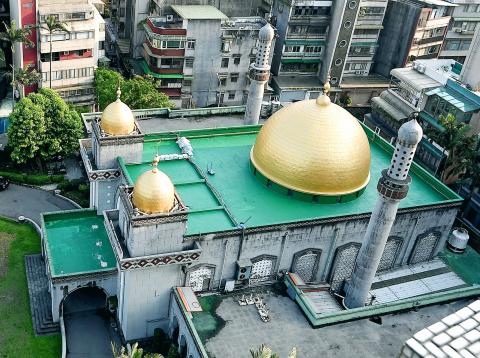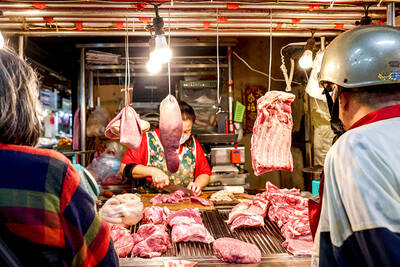Spring has arrived, and the mosque has had a makeover. Sharp-eyed people may have noticed that the domes on the prayer hall of Taipei’s Grand Mosque have quietly changed from green to gold. A spokesperson for the mosque explained that the prayer hall domes were originally covered with copper, which turned green after more than a decade of corrosion, but before the Lunar New Year they were repainted and became golden domes once more.
A city resident surnamed Huang said that although she passes the mosque every day when she picks her child up from school, she has never raised her head to take a close look at the changing street scenery. When asked about the change in the mosque domes’ color, she said with a laugh that it was a good thing, because a change in the cityscape meant a change of mood. Another resident surnamed Chen said that she goes to the nearby Daan Park at least twice a week for exercise, but had not noticed the mosque’s color change, and did not even know that the mosque domes used to be green.
Taipei’s Grand Mosque has a long history. During the 1950s, Taiwan was actively cultivating its diplomatic relations with Arab and Islamic countries, so, to accommodate the needs of visiting officials from Arab lands, then-president of the Chinese Muslim Association Pai Chung-hsi and foreign affairs minister George Yeh proposed building a large mosque in Islamic style. Finally Taiwan, Iran, and Jordan jointly raised funds and in 1958 appointed architect Yang Cho-cheng to design and build the mosque, which was completed in 1960, so that it has been standing in Taipei for more than 50 years.
(Liberty Times, Translated by Julian Clegg)

Photo: Chu Pei-hsiung, Liberty Times
照片:自由時報記者朱沛雄
春天來了,清真寺也換新裝!眼尖民眾發現,台北清真寺的大殿圓頂,由綠色悄悄換成金色的「光明頂」。對此,台北清真寺解釋,大殿圓頂最早是以金屬銅打造,歷經十餘年的鏽蝕才變成綠色,年前進行塗漆作業將「金頂」還原。
黃姓市民說,每天接小孩放學都會經過清真寺,但從未抬頭仔細看街景變化,問及寺頂「變色」,笑說那樣也很好,改變市容也換心情。陳姓市民則說,每週至少兩天在附近的大安森林公園運動,對清真寺變色真的無感,甚至不知道寺頂原本是什麼顏色。
台北清真寺歷史悠久,一九五○年代末,我國積極拓展與阿拉伯伊斯蘭國家邦交,為因應阿拉伯國家官員來訪,當時中國回教協會理事長白崇禧與我國外交部長葉公超,提議興建具有伊斯蘭教色彩的大型清真寺,最後我國與伊朗、約旦和沙烏地阿拉伯共同籌募,委託建築師楊卓成於一九五八年設計興建、一九六○年竣工,坐落台北已五十餘年。
(自由時報記者何世昌、蕭婷方)

Pigs that are resistant to a deadly viral disease have been created by scientists at Edinburgh’s Roslin Institute. The gene-edited animals remained healthy when exposed to classical swine fever (CSF), a highly contagious and often fatal disease. The virus was eradicated in the UK in 1966, but there have been several outbreaks since and it continues to pose a major threat to pig farming worldwide. “Classical swine fever is a devastating disease for livestock and farmers as we saw with the outbreak in the UK, 25 years ago,” said Helen Crooke, mammalian virology deputy leader at the Animal and Plant Health Agency

Have you ever seen a circular intersection where cars continuously flow in one direction around a central island? That is a “roundabout,” a well-known alternative to traditional intersections. Drivers enter and exit at different points without relying on traffic lights. Their primary purpose is to improve traffic flow and minimize the likelihood of high-speed collisions, particularly dangerous T-bone and head-on crashes. Roundabouts have existed and been implemented for over a century. In the 1960s, the modern roundabout emerged in the UK, with added rules for yielding. Unlike intersections with red lights, roundabouts allow vehicles to continue moving at a

A: So you’re reading Jin Yong’s martial arts novel again? B: Yup, Jin’s novels are so fascinating, especially the trilogy: “Legends of the Condor Heroes,” “Return of the Condor Heroes,” and “Heaven Sword and Dragon Saber.” A: The late novelist published his first story in 1955, which means this year marks the 70th anniversary of his “wuxia” world. B: Wasn’t an English version of “Legends of the Condor Heroes” also released in 2018? A: Yes, but the debate over the translation of kung fu moves continues — like the evil move “Nine Yin Skeleton Claw.” A: 你又在重讀金庸的武俠小說啦? B:

A: Apart from Jin Yong, the late martial arts novelists Liang Yusheng and Gu Long were also very popular. B: Wasn’t Liang a pioneer of the “new school” wuxia genre in the 20th century? A: Yup, I really like his Tianshan mountain series. All the characters — such as the “White Haired Demoness” — are so vivid. B: The roles in Gu’s books are lively, too — like the “Fragrant Commander” Chu Liuxiang. A: And the TV drama adapted from the Chu Liuxiang series swept across Taiwan in the 1980s, with ratings surging over 70 percent at that time.